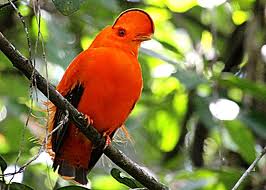

Guyana has over 815 migrant and resident bird species. Whether you are a beginner or keen birder, watching spectacular species of birds freely flying overhead and whistle will be an unforgettable experience. From the range of parrots, toucans, the harpy eagle, Guiana Cock-of-the-Rock, Blood-Coloured Woodpecker, Crimson Fruit crow, and the Elusive Rufus-Winged Ground-Cuckoo, Guyana is indeed a bird paradise and a place where birders should always visit.
Birding hot spots in Guyana
• Georgetown (capital city) - a wide range of parrots and other species can be seen in the National Park, Promenade and Botanical Gardens and the Georgetown Seawall.
• Kaieteur National Park - the Guiana Cock-of-the-Rock, Orange-Breasted Falcon, white-Chinned and White-Tipped Swifts are the species that could be seen here in abundance.
• Iwokrama - Blue-Checked Amazon, Merail Guan, Guiana Red-Cotinga, Rufous-Throated Antbird, Waved Woodpecker, Ducsky Pupletuft, Painted Parakeet and White-Winged Potoo are just a few amongst the hundreds that can be seen in this area.
• The Rupununi - Harpy Eagle, Cayenne Jay, Finsch’s Euphonia, Double- Striped Thick Knee, Green-Tailed Jacamar, Pinnate Bittern, Crestless Curassow, Bearded Tachuri are only some of the species that can been seen regularly here.
• Essequibo Region - Pointed-Tailed Palmcreeper, Paradise Jacamar, Red-Bellied Macaw, Black-Necked Aracari, Painted Tody Flycatcher, Spotted Antpitta and just few bird amongst the hundreds that are found in the Essequibo.
• Coastline Areas - an emerging new destination for birders and the habitat for the national bird of Guyana, the Hoatzin. The Hoatzin can be seen in the Mahaicony/Abary areas in great numbers. Many migratory species of birds also nested along the coast and can be seen every day.
Bird tour operators
• Evergreen Adventures (www.evergreentours.com)
• Evergreen Adventures (www.evergreentours.com)
• Rainforest tours (http://www.rftours.com)
• Arrowpoint (http://www.roraimaairways.com)
• Wilderness Explorers (www.wilderness-explorers.com)
• Shell beach Adventures (www.sbadventures.com)
Sports Fishing
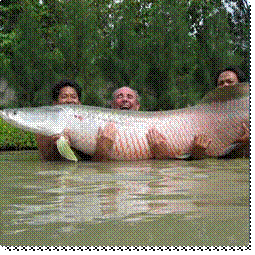 Known as the “Land of Many Waters” or the “Big River Country”, Guyana’s rivers are still unspoilt as it awaits your first cast. Sport Fishing is a new area of tourism attraction in Guyana with many unchartered river terrains virgin to man. Let your cast be the first in the next fishing season.
Known as the “Land of Many Waters” or the “Big River Country”, Guyana’s rivers are still unspoilt as it awaits your first cast. Sport Fishing is a new area of tourism attraction in Guyana with many unchartered river terrains virgin to man. Let your cast be the first in the next fishing season.
Fishing Seasons in Guyana
Guyana has two very productive fresh water fishing seasons. Mid February to late April and late August to late November are very good time of the year to go up river. During this time, the rains would have stopped and the water receded from the savannahs and forest floors. By the middle of the dry season, the rivers usually become narrow as the water recedes. This makes fishing more exciting as less water means less space per fish and more competition to feed and to survive predators of the river.
Game Fish Species in Guyana
Guyana shares with the Amazon River over 1800 fish species. Among those are several Game Fish Species such as the Payara, Arowana, Himara, and what is considered by professional anglers worldwide as the world’s most popular Fresh Water Game Fish, the Peacock Bass (Lukanani).
Fishing Hot Spots in Guyana
Guyana’s prime fishing locations are up the Essequibo River and along its tributaries below river rapids and water falls such as Rockstone and the Gluck Island, the New River Area, Kurupukari River and the Rupununi Burro Burro River.
Getting to the fishing hot spots
Fishing Tour Operators will take you the most thriving fishing grounds to ensure that your catch is rewarding. See listing below:
Fishing Tour Operators:
Wilderness Explorers Tours
Cara Suites, 176 Middle Street, Georgetown
Tel: 592 226 2085
Tours R Us
Thomas Street, Kitty, Georgetown
Tel: 592 621 7556
Wonderland Tours
85 Quamina and Carmichael Streets, Georgetown
Tel: 592 225 3122
Roraima Tours
(Bilingual guide service provided upon $request$)
E-Mail ral@roraimaairways.com
Telephone (592) 225-9648
Fax (592) 225-9646
Shopping
 Whether you are on Regent Street or in Charity Village, shopping should never be omitted from your itinerary while in Guyana. From gifts and jewellery to crafts and clothing can be found in this wonderful land, you name it they have it!
Whether you are on Regent Street or in Charity Village, shopping should never be omitted from your itinerary while in Guyana. From gifts and jewellery to crafts and clothing can be found in this wonderful land, you name it they have it!
Street vending, markets, arcades, malls and stores are very common shopping areas. Guyanese are very creative people and their talents are showcased through the originality and ingenuity found within their products. Handmade shoes/slippers, sculpture, paintings, ornaments, key rings, leather crafts and beaded crafts are just some products our local craft industry produces.
Guyana’s gold and diamonds are of finest quality with exquisite designs and unique patterns being the norm. Most of the pieces are locally handmade and can be found in many of the jewellery stores. The great hospitality of the Guyanese people is evident as one shops for almost anything, from fresh fruits and vegetables to exquisite souvenirs at very reasonable prices.
Trekking
The Amazon Rainforest of Guyana provides an amazing trekking experience. Through the rugged mountains and wild tropical rainforest are numerous developed trails frequented by the smiling faces of the Indigenous peoples as they journey to their farms. Take a guided trek and learn about the hundreds of plant species seen and used for many cosmetics and medicinal purposes. Be entertained by the whistling and mate dancing birds as they show off in their natural habitat and observe silence for a peep at the lizards and rodents who camouflage themselves among the trees.
Mountain climbing
Looking for that once-in-a-lifetime opportunity of mountain climbing? Visit Guyana and travel to the largely uninhabited south-western corner of Guyana’s Amazon Tepui region to the 2000 foot prow of Mt. Roraima, one of South America’s most mysterious landmarks which form the tripartite border of Guyana, Venezuela and Brazil. It has a unique development of flora which huddles for shelter in pockets on the exposed, windswept plateau. Amazing rock formations have been carved by wind and water, and the ground is uneven and rocky with frequent crystal clear pools of excruciatingly cold water (good for the circulation apparently!) There are crystal beds that contain large, individual crystals in interesting shapes, and stunning views.
Tours Guyana
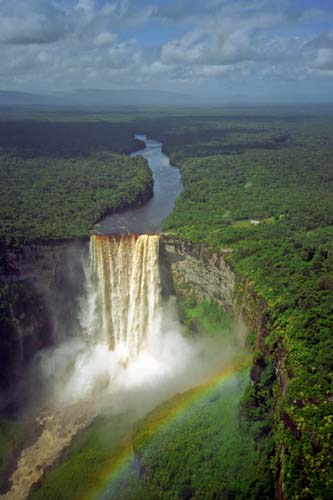 Kaieteur Overland Tour
Kaieteur Overland Tour
Envision 45, 000 gallons of lush black water thundering down a rock escarpment every second. Wonder in the sky dance of thousands upon thousands of scissor-tailed Swifts or soak in the culture of the prolific mountain hunters, the Patamonas. Take the overland journey through dense jungle for nights besides refreshing and scenic waterfalls, while pondering the language of the wildlife.
Then take the 1,800 feet mountain hike to experience the magnificence of the 741-feet single drop waterfalls.
Essequibo River Tour
An early start to the day will take you by bus to the departure point of the small market town of Parika. From here we may take an open boat up the mighty Essequibo River. The first stop will take you to an Old Dutch Fort where artefacts are still being found onto this day. After a tour of the fort you may head off for a visit to a “River Beach” called Saxacalli. Further up the river you can visit the frontier town of Bartica. Bartica is the hub of activities and recreation of miners who work the many gold and diamond claims of the interior.
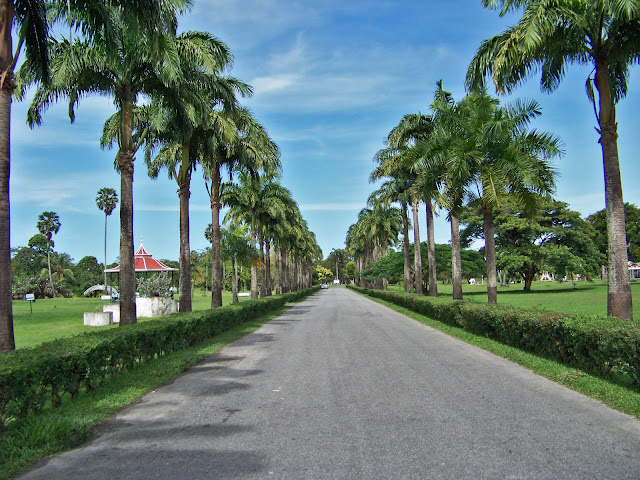 City Tour
City Tour
Georgetown is the Capital and largest town in Guyana. The town was designed by the Dutch as an outpost to protect their settlement during the 17th century. Georgetown is referred to as the 'garden city' and boosts a combination of wood work and concrete buildings dating back to the early 19th century. The St. Georges Cathedral purportedly the largest wooding building is found in Georgetown along with the famous Stabroek Market, the Kingston Seawall and Bourda Cricket Ground.
Guyana's El Dorado Rum tour
Voted among the best Rum in the World and a winner of several medals, the El Dorado Rum is a line of production by the Demerara Distillery Limited. Visitors will see how this unique blend of Eldorado 5, 10 or 15 years old rum is produced. The very ancient technique of rum making is alive in Guyana from Continuous Stills, Wooden Coffey and Wooden Pot Stills which are all used to produce this rich blend of El Dorado rum.
Community Tourism
The Indigenous communities of the Amazon Rainforest in Guyana offer a unique community tourism experience. The friendly Macushis and Patamonas of Surma and Wowetta in the Rupununi and the Arawaks of Santa Mission invite you to spend a few days and experience their traditional Indigenous culture. Be amazed at the processing and taste of food and beverage from cassava [root tuber] and be wowed at the cultural performances. Don’t miss their intriguing folklore and rainforest tales in the open air, while star gazing. Sleep in the comfortable benab setting and wake up in the morning to the call of birds and insects, while your friendly host prepares you a scrumptious breakfast followed by a fun filled day of trekking, birding, canoeing, swimming, fishing and observing handicraft made from forest products and many more.

Guyana’s Natural Beauty
Mountains:
The Guiana Shield is formed some two billion years ago during the Precambrian period. The shield is covered with 2.5 million km sq of tropical forest. The massive granite craton underlying the Guyana Shield are covered with sandstones, quartzite, shales, conglomerates and boulder beds. The Guyana shield is the world's largest remaining tract of mostly undisturbed and unexplored tropical rainforest and is one of the only four such remaining forest in the world.
Mount Roraima
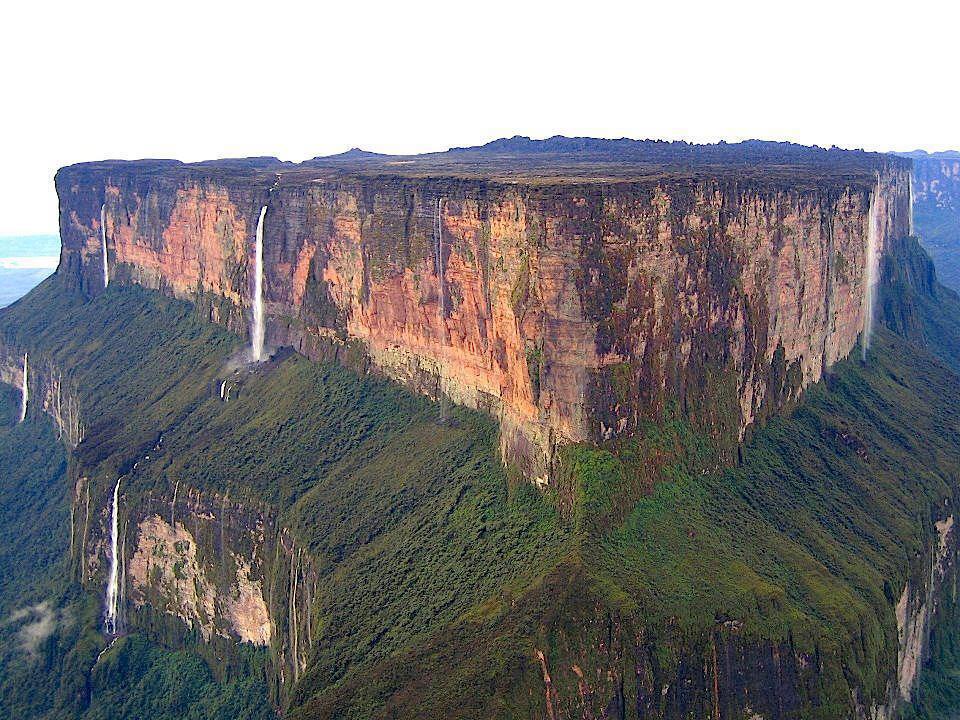
Is the most famous Tepui in the World. Over 1,700 million years old, this ancient formation is one of the most acclaimed sights in South America forming a tripartite border between Guyana, Venezuela and Brazil. For hundreds of years this ancient flat-topped mountain formation inspired travellers - tales and rumours abounded concerning the mysterious, inaccessible summit above the clouds.
Mount Roraima is the highest point in Guyana with a plateau standing at 2700m. Forming part of the ancient Guiana Shield, Mt. Roraima was once part of Gondwanaland before tectonic activity moved apart the continents of Africa and South America. The lunar-like surface is home to many unique flora species which huddles for shelter in pockets on the exposed, windswept plateau. Amazing rock formations have been carved by wind and water, and the ground is uneven and rocky with frequent crystal clear pools of excruciatingly cold water (good for the circulation apparently!) There are crystal beds that contain large, individual crystals in interesting shapes, and stunning views.
Mt. Roraima has made a deep impression on western literature and thought, influencing such men as Charles Darwin and Sir Arthur Conan Doyle. After the publication of Darwin's 'Origin of Species' there was great public interest in 'missing links' and 'relic species' preserved by isolation. Roraima's mysterious summit was an excellent possibility for an area at evolutionary standstill and the last place on earth where dinosaurs could exist. Conan Doyle, fascinated by the descriptions of early explorers such as Im Thurm, wrote in 1912 what is considered to be one of the best science fiction novels ever written - "The Lost World."
Kanuku Mountains
The Kanuku Mountains – recognized by Conservation International as being one of the few remaining pristine Amazon habitats - is located in south-western Guyana. This picturesque mountain range forms a spectacular backdrop to the Rupununi Savannahs with its sculptured crowns peaking just below the clouds.
The range, divided by the Rupununi River, is noted for its high diversity of bird and animal species, with approximately 80% of the known mammal species of Guyana being recorded. With little or no human settlement on the eastern range, the area is still pristine and is perfect for the nature and adventure traveller to experience the diversity of the tropical ecosystems.
A trip down the enchanting Rupununi River provides you with the opportunity to see Black and Spectacled Caiman, Puma, Tapir and Giant River Otters. Explore forest trails that lead into the virgin Kanuku Mountains in search of the Harpy Eagle, the Cock of the Rock, Cotingas, Three-toe Sloth, Tyra and many more exotic animals.
The Pakaraima Mountains
The Pakaraima Mountains are found in central and western Guyana along the Venezuela/Brazil border. This mountain range covers a distance of roughly 500 miles, is part of the Guyana Shield and populated with many tepuis, or flat-topped mountains.
Waterfalls
Guyana boasts more than 300 glorious waterfalls, including the world's famous Kaieteur Falls which is five-times the size of Niagara Falls; King George V1 falls measured at 525 feet; and King Edward V111 Falls, which is measured at over 850 feet.
In addition to the above, is the Amaila Falls which is located on the Kuribrong River (Potaro-Siparuni Region). It is a tributary of the Potaro River in the central western region of Guyana .The river drops from the escarpment over Amaila Falls vertically approximately 200 feet, and continues in a series of rapids and falls for almost two miles before reaching placid water at an elevation of 175 feet. The total drop is about 1,200 feet. During the course of the falls the river changes direction from east to north.
The Government of Guyana is currently working on a project to create a hydro-electric dam at the Falls to generate electricity for the national grid and existing large mining operations, with future expansion capacity to power major industrial growth projects within Guyana. The project has the potential to produce 100 MW, sufficient to provide power to most existing users in the country.
Barrington Brown Falls is a waterfall on the Courantyne River, Guyana, approximately 250 km south of Orealla .
The Cuquenan Falls (also spelt Kukenaam and similar) at 2,000-feet in a single drop, are amongst the 15-highest free-leaping waterfalls in the world. They are located on a tributary of the Arabopo River, which rises on the Cuquenan Plateau , at Mata Hui, near the borders of Venezuela and Brazil . It is actually located in western Guyana and it's also one of the world's most isolated and untouched waterfalls.
Drios Falls is a waterfall on the Courantyne River, Guyana, approximately 245 km south of Orealla .
Kaieteur Falls is a waterfall on the Potaro River in central Guyana. It is located in the Kaieteur National Park. It is 226 meters (741 feet) when measured from its plunge over a sandstone cliff to the first break. It then flows over a series of steep cascades that, when included in the measurements, bring the total height to 251 meters (822 feet).
The King Edward VIII Falls is found on the Courentyne River in southern Guyana. With a height of 259 metres (850 feet) it is the 34th highest waterfall in the world.
King George VI Falls is located on the Courantyne River in southern Guyana. It is the 19th highest waterfall in the world. Commonly known as King George Falls or King George VI Falls, Salto Oshi is a sheer plunge of about 525 feet. The falls were reportedly discovered by Danish scientist Paul A. Zaul in 1938.
Kumaka Falls is a waterfall on the Essequibo River, Guyana, approximately 5 km north of the confluence with the Potaro River.
Kumarau Falls, located in Cuyuni-Mazaruni Region is considered to be the sister waterfall to Kaieteur. Its spectacular sheer drop of 620 feet and 200 feet width makes it equal in aesthetic and scientific value to Kaieteur. On the sandstone plateau near the falls lie typical floristic elements for the Guiana highland region, including gaints bromlaids, Clusia orchids, Stemnodendron, Utricularia and Xyris species.
Great Falls (aka Kamarang Great Falls, Kamarang Falls) is approximately 700 feet tall and consisting of one drop.
Maopityan Falls is a waterfall on the Courantyne River , Guyana , approximately 245 km south of Orealla
Murrays Fall is a waterfall on the Essequibo River, Guyana approximately 55 km south of the confluence with the Rupununi River .
Marina Falls - approximately 500 feet in height and 2 drops
Orinduik Falls lie on the Ireng River, a highland river that thunders over steps and terraces of jasper on the border with Brazil before merging with the Takutu River and into Brazil to join the Amazon River .The falls are situated amid the rolling, grass-covered hills of the Pakaraima Mountains . Orinduik Falls is ideally suited for swimming.
Pot Falls is a waterfall on the Essequibo River, Guyana approximately 30 km north of Kurupukari .
Rappu Falls is a waterfall on the Essequibo River , Guyana , approximately 17 km north of the confluence with the Rupununi River .
Waraputa Fall is a waterfall on the Essequibo River , Guyana , approximately 11 km south of the confluence with the Potaro River .
Beaches
Bartica Beach
Bartica, once known as the 'Gateway to Guyana's Interior' is a relatively small town and is located in the Essequibo region. Beaches found along Bartica northern end are ideal for swimming and locals mostly ‘lime’ (hang out) and party until dawn on the beach.
Hamburg Beach on Tiger Island
This beach is along a private Island and is ideal for a getaway. Many people converge on this beach to have picnics and parties on the weekends and holidays. Every first Monday in August, more than 15,000 visitors converge on this beach for a grand Hamburg beach fete in celebration of Emancipation Day in Guyana.
Saxacalli Beach
Saxacalli is originally an Arawak community located on the left bank of the Essequibo River some 25 miles from Parika. This community is reputed to have one of the best inland beaches in Guyana. Visitors can go on day-trips to Saxacalli and enjoy a swim at one of the finest beaches in the mighty Essequibo river.
Shell Beach
Journey to the north eastern Atlantic coast of Guyana in the Barima Waini Region to Shell Beach! This 90 mile stretch of relatively uninhabited coastline is known mainly as a nesting ground for four species of endangered marine turtles which come to nest here annually.
The area itself however, is a unique ecosystem encompassing mangrove forests, inland swamp forests and savannahs and bordered by the Atlantic seaboard where mud-flats front the shore in some areas. Apart from the four species of endangered marine turtles (Giant Leatherback, Hawksbill, Olive Ridley, and Green Turtles) the area is known to possess giant river turtles as well as tortoises, along with manatees, tapirs, deer, jaguars, howler monkeys and other large animals.
The bird diversity is one of the richest in Guyana and includes many species of parrots and macaws, numerous wading birds including many scarlet ibis and Caribbean flamingoes, herons, egrets among a host of others. The ecosystem of Shell Beach has remained relatively intact over the years due to the absence of large settlements along the beach and surrounding areas. This has been due mainly to the inaccessibility of the areas as well as the inhospitable nature of the mangrove swamps. Over the years though a few communities have built up along the beaches and are mainly Amerindians from other villages within the wider area.
63 Beach Berbice
63 Beach is found north of Corriverton and located in No.63 Village on the Corentyne. Every week this beach is visited by more than 3000 visitors. The Beach is approximately 10 miles spanning more than 12 villages. It is ideal for beach volleyball, softball cricket, fitness, relaxation, swimming, fishing and a host of other beach-related activities.
The Rupununi Savannahs:
The Rupununi Savannah is one of the World’s largest untouched open ranges of savannah lands, which is characterized by flat grasslands and mountainous terrains. It is located between the Rupununi River and the Brazilian border, in the Upper Takutu-Upper Essequibo region. The Rupununi Savannah, an extraordinary natural area in southern Guyana is teeming with wildlife, including 500 bird species, 1,500 different plant species, more than 400 species of fish, 120 species of snakes, lizards and frogs, 105 mammal species including the elusive Jaguar which roams the hills and mountains while the Harpy Eagle flies overhead.

Three of Guyana’s Amerindian tribes; Wapishana, Wai Wai and the Macushi, inhabit the Rupununi Savannah areas in several Amerindian villages dotted throughout, as well as many ranches worked by vaqueros (cowboys), some of whom are descendants of 19th century Scottish settlers. The main town is Lethem, located beside the Takutu River, the border with Brazil. Lethem hosts the annual Rupununi Rodeo during the Easter holiday weekend; many Guyanese travel cross country to attend the event.
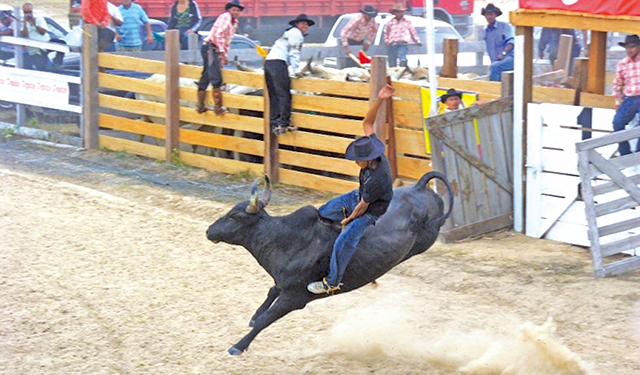
A Vaquero at the Rupununi Rodeo, Guyana
Wetlands
The North Rupununi wetland is the largest wetland found in Guyana. It covers 22,000 hectares of flooded savannah and forest. The North Rupununi wetland is dominated by the Rupununi, Rewa and Essequibo Rivers and include over 750 lakes, ponds and water inlets. More than 400 species of fish, the highest diversity of fishes in the world for areas of similar size is found in the Rupununi wetlands. This area is also home to some of the world endangered giants - the Arapaima (largest fresh water fish), the giant river otter (largest of the 13 otter species), the black caiman (world’s largest of subfamily Alligatorinae), Giant river turtles, the harpy eagle (the largest bird of prey), the jaguar (the largest cat in South America) and hundreds of other flora and fauna.
The Rupununi Wetlands plays a very important role in the lives of more than 5000 indigenous people of Guyana. The rivers and waterways found in the wetlands act as a source of drinking water and a main transportation routes for the people living in the Rupununi.
The vegetation found in the wetlands are used by our indigenous tribes to make crafts, traditional medicine, houses and sometimes food.